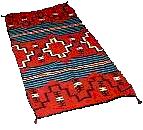
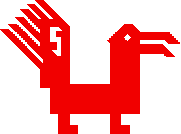
Navajo Rug Appraisal Co.®
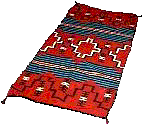
The information on this page is designed to be helpful to the owner or purchaser of Navajo rugs and will include the author's interpretations and explanations in the attempt to clarify the often confusing world of Indian arts and Navajo rugs.
-
Direct Dye A dye that can be applied without the use of mordant. Cotton is often dyed this way but it is sometimes used for wool.
Dry Rot The damage as a result of mildew. It is the break down of fibers because of moisture and the growth of fungi. Cotton is more susceptible to dry rot but wool can also be affected. Dye run, staining and discoloration can also accompany the dry rot. Remedy usually requires the reweaving or stabilization of a large area of the rug or blanket.
End Cords Two or three plied cords that interlace along the end edge of the weaving. The cords alternate along the ends and, during weaving, serve as a means of securing the warps to the upper and lower beams on the traditional upright Navajo loom. All Navajo rugs have end cords, at least at one end but most Navajo rugs have cords at both ends.
Eyedazzler A Spanish influenced style of Navajo weaving incorporating intricate serrated designs and bright, synthetic colors. The term usually refers to Germantown blankets/rugs with very colorful and intricate patterns but it can also refer to textiles woven of handspun yarns.
 Germantown Eyedazzler
Germantown EyedazzlerFerrous Sulfate FeSO4 7H2O. Iron mordant used to produce dark colors. It tends to weaken the wool.
Flexibility A term sometimes used by Indian arts dealers to describe the feel of looseness of a weaving implying that the Navajo rug is very finely woven.
Fushine A synthetic "aniline" dye invented about 1858 by Hofmann and Nicholson and used extensively in the decades after. Magenta is another name for the same dyestuff.
Gallup Throw A type of small Navajo weaving sold as curios. This type of rug has tied-off warp ends at one end with the other end having the normal end cord finish.
Germantown A term for machine spun three and four ply wool yarns. Named for a suburb of Philadelphia where much of the yarn was produced. It was first used by the Navajos in the late 1870s and used it extensively to about 1910. Blankets and rugs made from Germantown yarns are much more even in texture than those made from handspun yarns. Oftentimes Germantown blankets and rugs were woven on machine spun and plied cotton warps. Germantown rugs and blankets sometimes have the warps at one end tied off in a square knot rather than looped back.
Hair Along with wool, sheep also produce some hair. As opposed to wool, the hair fiber contains a medulla that consists of a cellular structure of air pockets. Wool yarn will often contain some hair fibers and a small amount can add to the luster and durability of a rug.
The weight and stiffness or flexibility of a rug. A rug´s handle might be described in terms such flexible, stiff, of soft.
Hogan The traditional round shaped one room Navajo home made of mud and wood.
Inherent Vice Deterioration caused by the inherent nature of the item and not the result of a casualty or external cause. An inbuilt tendency to self-destruct. The corrosion or gradual deterioration of fibers because of the use of corrosive dyes and/or mordants (in some dark brown colors) would be an example.
Indigo Dye produced from the indigo plant (Indigofera Tinctoria) as a source for the color blue. It is one of only two natural vat dyes (the other being Tyrian Purple that was too costly for use in Navajo weavings). In early times, the Spanish brought Mexican Indigo by mule train to the Spanish villages along the upper Rio Grande river. It was traded indirectly to the Navajos by way of the Pueblo Indians.
Kemp In addition to wool and hair, a sheep will also produce a very course fiber in very small amounts. This fiber has a very large medulla and is thick and brittle.
Killer Piece Pronounced, "Killlllerrr Peeees." A name used by Indian arts dealers to describe an exceptional rug or blanket. The term is often preceded by qualifying statements such as, "if it didn't have the dye run, it would be a..." Usually when the phrase is used, the rug looks more like the victim of homicide rather than the perpetrator. Caution should be exercised because if one hears the term too often, extreme nausea can result and IQ level will drop dramatically.
Lac A natural dyestuff that produces a red color. It is the dyestuff derived from the secretions of the Lac insect (Laccifer lacca). Fabric dyed with lac was exported by Spain to North America and ultimately traded to the Navajo. This fabric, which sometimes had been dyed with a combination of lac and cochineal, was then raveled by the Navajo weaver and used in the Navajo blankets. The lac dyestuff itself was not available to the Navajos for use on their own handspun yarns.
Lanolin Wool grease, wool fat. The fat-like sebaceous secretion of sheep. Actual lanolin is the refined wool grease. Thought to be an important factor in the luster, softness and flexibility of the wool yarn in a Navajo rug. However there is no lanolin in contemporary machine spun wool yarn used in Navajo rugs and there is likely little or none left in older rugs.
Latent Defect A flaw, fault, imperfection or irregularity not readily observable or easily discovered; not patent. In a Navajo rug a latent defect may be unevenly spun or strung warp threads that will later shrink unevenly from humidity or moisture, creating a seersucker affect. This defect could not have been detected by ordinary means.
Lazy Line Section Line A diagonal line resulting from the Navajo weaver working on one section of the rug at a time without having to weave across the entire width with each pass of the weft thread. The line can sometimes extend through several colors and design elements. More properly called a "section line" because the term is more accurate, more accurate and less derogatory to the Navajo weavers.
Madder Dyestuff from the plant Rubia tinctorum. Produces a red, orange, reddish brown, purple or black. The dyestuff component of madder, alizarin, was first synthesized in 1870 and replaced the natural dyestuff almost completely.
Manta A woman's blanket, woven wider than long and in slightly smaller dimensions than the Chief's blanket.
Merino Wool Wool from Spanish Merino sheep which have wool grades of 23 microns or finer. It is lustrous and soft but is more suited for machine spinning than hand spinning. It was used in Transitional Period blankets/rugs.
Mohair Fiber (hair) from the fleece of Angora goats. It is sometimes used in contemporary Navajo rugs that have been woven with machine spun single ply yarn of 100% mohair or wool/mohair blend from the Brown Sheep Yarn Co.
Moki A design style having blue, brown striped background. Spanish word for Hopi. Used by Navajos to refer to the Hopis.
Mordant A chemical that does not introduce its own color in a dye bath but is necessary for the dying to occur. It is analogous to a catalyst. The use of different mordants can influence the ultimate color. Alum and urea are examples of mordants. Salt (sodium chloride) is not a mordant but is more properly termed an assistant.
Natural Dyes Any non-synthetic dyestuff. Also refers to the colors that appear to be produced from natural dye sources. Very rarely used in blankets before the "revival period" of the late 1930s.
Natural Wool Colors The natural colors of undyed wool. By carding two colors of ivory and dark brown or black, grey colored yarn is produced.
Pendleton Blanket Wool trade blankets produced by the Pendleton Woolen Mills. There are several other manufacturers as well. Very popular with American Indians in the late nineteenth and early 20th century and traded to the Navajos in exchange for Navajo rugs and raw wool.
Picker A person that searches yard sales, flea markets and auctions for merchandise to sell to retail dealers. The picker is motivated by the dream of finding treasure amongst trash. Usually only the latter turns up.
Pictorial Weavings Rugs having a design depicting ceremonies, everyday life or other realistic or semi-realistic motifs.
Pulled Warp Technique Navajo wedge weave blankets and rugs that have wefts at an oblique angle to the warps, creating uneven tension and thereby pulling the warps out of their straight longitudinal arrangement. Sometimes called "Wedge Weave."
Pound Rug Coarsely woven rugs. Reservation traders bought and sold these rugs by weight rather than by the individual piece. This was a very common practice that continued at least into the 1960s,
Provenance The history of ownership or origin. If an item was owned (or even touched) by a famous person, then often the value is increase. For instance, if a Navajo blanket was known to have been owned by Kit Carson, then it could be of greater value then one of unknown provenance. Because of this fame/value factor, one should be wary of sellers puffing up the value of their merchandise with optimistic stories.
Quincunx An arrangement of five design elements, usually with the largest in the center. A center medallion and corner motifs. A common styling of Oriental rugs and Islamic bookplates. Found in Navajo rugs during the Transitional period and later. The typical Two Grey Hills design is an example.
Raised Outline A style of weaving using alternating weft colors which produce a raised welt at the design changes.
Regional Rug A rug whose design characteristics pinpoint its origin to an area around an established trading post. Also a rug woven elsewhere but show regional design styling. See "Map of the Navajo Reservation." This author has not been able to find when the term was first coined but certainly the original trading post operators did not think of their rugs as having a regional identity. Contrary to the thoughts of many in the Indian arts business, many Navajo rugs are non-regional. In fact, most Navajo rugs do not show enough characteristics to pinpoint them to a specific regional area.
Reserve Price In an auction, a minimum selling price usually set by the seller an agree to by the auctioneer.
Restoration Methods used to restore the damage to a rug or blanket into the condition of the rest of the piece. This type of work involves reweaving to restore the function as well as the esthetics of a Navajo rug or blanket. Quality restoration requires special ability and skill along with proper materials and dyes.
Rio Grande Blanket Blankets woven on horizontal European style looms by Spanish settlers living along the Rio Grande river in New Mexico and southern Colorado.
Saddle Blanket A blanket made for use under a saddle. They are woven in single and double sizes, the double saddle blanket is made to be folded in half and used double thickness. Fancy ones were made to be used over the saddle for dress up.
Saltillo Serape Intricately patterned and very colorful serapes woven in Northern Mexico. The designs of these weavings influenced and shared the style of the Rio Grande blankets which influenced the designs of Navajo weavings primarily in the last third of the 19th century. Saltillo serapes were woven by Tlaxcalan Indians beginning in the early seventeenth century. Saltillo style weavings are still being made today.
Sandpainting A temporary painting made from colored sands and other materials used in a Navajo ceremony. Sometimes called drypainting. A rug depicting a sandpainting.
Saxony European machine spun, natural dyed, three ply Merino wool yarn. The first commercial yarns available to the Navajos. These yarns were imported from Germany and were available in the southwest as early as 1850. It is found in Navajo blankets made from about 1860 to 1880. Saxony yarns were available in red, green, blue and ivory.
Selvage The side edge of a fabric.
Serape A wearing blanket that is woven wider than long and made to be worn horizontally, wrapped around the shoulders. Poncho style serapes were woven with a slit opening for the head and were made to be worn draped in the front and back. Sometimes spelled as Sarape.
Shed During weaving, an opening of the warp threads allowing a weft thread to pass.
Side Cords Two or three plied cords that interlace along the side edge of the weaving. The cords alternate along the sides and serve as the last edge warp. Most Navajo rugs have side cords.
Slave Blanket A blanket woven on upright looms by Navajo women servants working in Spanish households. These blankets display both Navajo and Spanish design styles.
Spirit Line A weft line usually in the upper right hand corner extending from the background of the rug usually to the very edge. Also called the "Weaver's Pathway." Not found in all Navajo rugs. It is to prevent a weaver's spirit or creativity from being imprisoned within the border of the rug.
Storm Pattern Design style having an arrangement of 5 rectangles or squares in a quincunx pattern. These design elements are connected by stepped (zig-zag) lines. This style of weave is associated with Tuba City but is woven throughout the reservation.
Swastika A design element first appearing in Navajo weavings during the Transitional Period but more prevalent in the first third of the 20th century. It was introduced in some way during the early trading post days. In Navajo rugs, it is a design element unrelated to the "Whirling Logs" sandpainting motif. The swastika design is not found in rugs woven after the mid or late 1930s due to the association with the Nazis.
Tapestry Weave In the Indian arts world, the term means a weaving having more than 80 wefts per vertical inch. The true definition of tapestry weave would be that of a weft-faced plain weave construction.
Tassels Corners resulting from the end and side cords extending beyond the weaving and tied off to prevent raveling. Sometimes these tassels are embellished with additional yarns.
Teec Nos Pos A Navajo term meaning "Circle of Cottonwood trees." It is a trading post "regional area" in the northeast corner of Arizona characterized by very intricate and colorful styling similar to that of some oriental rugs.
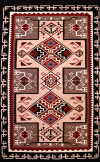 Teec Nos Pos rug
Teec Nos Pos rugTrade Cloth Machine spun and woven cloth available in piece and bolt form traded to American Indians. Bayeta is a type of trade cloth.
Trading Post Stores licensed by the Bureau of Indian Affairs, after 1868, to trade on the Navajo reservation.
Transitional Period This period is when the Navajo were adapting from weaving wearing blankets which were sold to Spanish and Plains Indians to weaving rugs that were to be sold to Anglos. See "History of the Navajo Rug."
Twill Weave Type of weft float weave in which the wefts pass over multiple warps creating diamond, herringbone or diagonal patterns. Twill weave seems to be an innovation of the first quarter of the 20th century and is most often found in saddle blankets.
Two Faced Weave A type of weaving having a different design on each side. Originated during the Transitional Period of Navajo rug weaving and is sometimes found in contemporary rugs.
Two Grey Hills A trading post and "regional area" in western New Mexico. It is known for very finely woven rugs in colors of black, grey, brown, tan and ivory. These rugs usually have a diamond shaped center medallion and corner motifs surrounded by a narrow geometric or plain stripe border.
Variation (color variation) The differences of color shade or hue due to changes in dye lot or wool batch. In the Indian arts world, there does not seem to be a special term for this phenomenon so it is usually referred to as "variation." Used in such a way, this term is synonymous with the Oriental rug term, "abrash." Variation in an older rug adds to the look of the rug. This is not seen as a defect but is sought after in older rugs. In contemporary rugs, this variation is, indeed, looked upon as a defect.
Vegetal Dye (Vegetable Dye) Any dye made from a plant source. Generic term of any natural dyestuff as opposed to synthetic dyes. Therefore the term "natural dyes" is more appropriate because the generic term includes cochineal. Rabbit brush, ironwood and juniper are examples of vegetal dyestuffs.
Warp Thread The foundation thread that rugs vertically. Threads of yarn that extend through the entire length of the rug. In most Navajo weavings, this thread is continuous across the rug and thereby turns back at the top and bottom.
Warp/weft Count The number of warps per horizontal inch and the number of wefts per vertical inch.
Wedge Weave First appearing during the Transitional Period, it is a style of weave in which the weft threads are at oblique angles to the warp. This is opposed to the usual method of having the wefts at right angle to the warp. Because of the angle and tension of the wefts, the warps are pulled and no longer straight. This causes the side edges of the blanket to become scalloped.
Weft Tension The amount of sinuousness of the weft thread (the horizontal yarn that forms the face of the rug). There is a tendency for a weaver to pull the weft slightly tighter as she weaves. This increased weft tension can produce a rug that is narrower at the top of the rug or one that is hourglass shaped.
Weft Thread This is the horizontal thread passed over and under the warps forming the face and design of the rug. All Navajo rugs are weft-faced.
Whirling Logs A design motif occurring in sandpaintings that depict a story that occurs in the Nightway ceremonies. Contrary to conventional wisdom, the Whirling Logs sandpainting design has no connection with the swastika which is found in Navajo rugs woven before the mid to late 1930's. Dealers will use the term instead of the actual name of swastika. See Swastika.
Wool Fiber from sheep. Only sheep produce actual wool. Wool fiber differs from hair in that it does not have a medulla. Sheep also produce a small amount of hair and kemp.
Woolen Yarn Wool yarn with fibers that are not completely parallel, having been carded only before spinning into yarn. Handspun yarn in Navajo rugs could be most often classified as woolen yarn due to the fact that it has been carded but not combed before spinning.
Worsted Wool yarn with fibers that have roughly parallel fibers due to having been combed after carding and prior to spinning. More often found in machine spun wool yarns.
Yei The Holy People of the Navajo belief system. Also refers to a rug with a design depicting a Yei deity.
Yei bicheii (Yei be chei) A dancer or dancers portraying the Navajo deities. Also a rug having a design of Yeibechai dancers.
Yellow Natural yellow dyes in Navajo blankets is available from the flowers of rabbit brush (Bigelovia graveolens), the roots of canyorgre (Rumes hymenosepalus) and from the blossoms and stems of chamizo (Attriplex canescerns).
Zapotec Indians of Oaxaca, Mexico (notably those of the village of Teotitlan de Valle) that weave rugs and blankets on the European style loom. These rugs often resemble or copy Navajo rugs and are oftentimes woven and sold as fakes.
Certified Accredited Appraiser

 Appraisers National Association
Appraisers National Association
Certified Accredited & Appraiser Expert Consultant ASSOCIATION of ONLINE APPRAISERS
ASSOCIATION of ONLINE APPRAISERS
Certified Member
NEW ENGLAND APPRAISERS ASSOCIATION National Association of Professional Appraisers
National Association of Professional Appraisers
Senior Professional Appraiser
Abrash This Persian word has entered English because there was no existing term to explain the abrupt as well as subtle changes in the intensity of color often seen in Navajo and Oriental rugs. Abrash is most commonly caused by the weaver using wool from different dye batches or dyed at different times in the vat. Yarns dyed towards the end of the process are normally lighter than those dyed at the beginning when the dye has been freshly prepared and is at full strength. Navajo rug dealers seldom use this term preferring to use the word, "Variation." See: Variation (color variation).
Acid Dye A class of synthetic dyes that contain acidic groups, such as sodium salts of sulfonic acids or phenolic groups. These dyes are applied from an acid dye liquor with acetic, sulfuric or formic acid and, as in the case of wool, usually a dye bath with a low pH. Acid dyes produce very bright colors that are fairly colorfast with regard to light. First developed in 1862.
Acrylic A copolymer of polyacrylonitrile. Usually copolymers of acrylonitrile and methyl acrylate or acrylonitrile and methyl methacrylate. Most often it is solution dyed (color added when the chemical is in its liquid state). It is an inexpensive substitute for wool yarn and not looked upon as being genuine when used in Navajo rugs.
Alizarin The component that produces the red color in madder (C14H6O2(OH)2. It can be made to produce various shades when used with different mordants. It was produced synthetically in 1870 which led to the production of a variety of synthetic colors produced from anthraquinone>.
Alum Potassium Aluminum Sulfate, K2SO4Al2(SO4)324H2O, a colorless cubic mineral occurring as an efflorescence in clay-rich rocks. Recognizable by an its having an astringent taste. Used by the Navajos as a mordant with a variety of dyes.
American Flannel The term generally refers to an aniline dyed fabric (rather than cochineal or lac) that was raveled by the Navajo, respun and used in blankets. It can be distinguished from Bayeta by the orange-red aniline color.
Anasazi The Navajo term for the "ancient people," the prehistoric Indians of the southwestern America.
Angle of Twist Measurement of the tightness of twist in wool yarn. It is the angle of the plies or fibers in relation to the direction of the yarn itself. The higher the angle, the tighter the twist.
Aniline Dyes Synthetic coal tar derived dye used in Navajo weavings from about the 1880s after the arrival of the railroad. There are some Navajo rugs predating the 1880s that show the use of aniline dyes, some dating to the Bosque Redondo period. The earliest aniline dye (mauvine) was invented (discovered) by William Perkin in 1856. Mauvine was too expensive to used in Navajo rugs but later synthetic dyes such as Fushine - Magenta were cheaper and were therefore used extensively. A more appropriate term for such dyes might be "synthetic dyes" distinguishing them from vegetal dyes.
Antique A term loosely used to describe an older object valued because of its esthetic or historical significance. An old item. Sometimes the term means an item over 100 years old (US Customs) but can also be used in reference to younger items. An antique might be an item that is no longer produced the same way or with the same look and does not compete in the market against new items. Navajo rugs from the 1920's -30's could be viewed this way.
Appraisal A third party, professional opinion, sometimes in writing, of the value of an item. Usually needed when an item is sold, contemplated to be sold, donated, insured, financed or documented for the future. Appraisals are needed for items such as Navajo rugs, where the value is not easily determined and for which there is not a fluid current market price. For instance, an ingot of gold would probably not need an appraisal, but a gold coin would. An appraisal is an estimate of the value of an item and should include relevant information justifying the stated value. The cost of a professional appraisal should be a flat fee - not one based on appraised value. Free appraisals are usually worth what you pay.
Attribution Assignment of a regional (trading post area) origin or category or type of weaving, sometimes with accompanying dating. Various criteria may be used along with evidence supporting that the Navajo rug meets the criteria. Sometimes both the criteria and the evidence are shaky.
Auction Pool At an auction, a group of people who agree not to bid against each other in order to keep the hammer price low. One person will bid for the group and, if successful, the group will meet separately to hold a private auction between themselves. Unsuccessful bidders in this private auction will then be compensated according to the difference between the first hammer price and the second. This whole process is illegal but is often done with the knowledge of the auction house.
Batten A tool used when weaving a Navajo rug. It is a flat stick used to open the shed. Ones that are about 18 inches long are commonly used but other sizes can be used as well, depending upon the weave and design.
Bayeta Spanish term for English baize, a red woolen trade cloth dyed with cochineal or lac (or both) and imported by the Spanish. This commercially produced wool cloth was raveled by the Navajo and respun for use in their own blankets. Pink could be obtained from Bayeta by raveling the cloth and carding in natural white wool and then spinning it to make new wool yarn.
Beam The horizontal bars (upper and lower), usually wood, upon which the warps are tied.
Beater Wood comb used to beat down the wefts during weaving.
Blanket Dress A traditional Navajo dress made of two blankets sewn at the sides and shoulders.
Bleeding Dyes of one color running into areas of other colors. It adversely affects the value of a Navajo rug and cannot usually be remedied successfully or without some odd color change, outlining or fading. De-bleeding is a goofy term used by some Indian Arts dealers to refer to some possible miracle that will turn their bad merchandise into good.
Block The process of stretching the edges and body of a rug and the application of moisture to straighten the edges and to flatten the rug.
Bosque Redondo Spanish for "circle of trees." Located in eastern New Mexico at Fort Sumner where the Navajos were imprisoned from 1863 to 1868.
Carminic Acid The dyestuff from cochineal.
Carding Preparing the wool for spinning into yarn by brushing (pulling) the wool fibers with two wire brushes in order to disentangle, straighten and align the fibers. This must be done before the wool is spun into yarn.
Carpet Beetle Four species of small, oval shaped beetles, may be either solid black or mottled with white, brown, yellow or black. The larvae have gold, brown or black bristles terminating in a tuft of long hairs and grow to be 1/4 to 1/2 inch long, depending on the species. The larvae feed on the wool and can cause severe damage to a Navajo rug. See Moths, Carpet Beetles and Other Insects.
Ceremonial Rug A rug depicting a sandpainting. Not used in ceremonies.
Chief's Blanket A horizontally striped wearing blanket woven wider than long and worn horizontally. These blankets are categorized into three design phases.
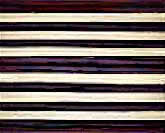 1st Phase Chief's Blanket
1st Phase Chief's Blanket
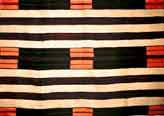 2nd Phase Chief's Blanket
2nd Phase Chief's Blanket
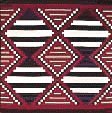 3rd Phase Chief's Blanket
3rd Phase Chief's Blanket
Chief's Blanket A distinctive style of Navajo shoulder blanket and some rugs that are made wider than long. Two zones of wide black and white bands are separated by a series of narrower blue, black, and/or red bands along the ends and across the blanket's center, often with diamonds, rectangles, or other geometric motifs placed in three rows of three motifs each (see Nine-spot pattern). For ease of identification, chief blankets are divided into four phases, although the patterns overlap in time and continued in use during the late nineteenth and twentieth centuries.
· First Phase (1800-1850) Simple weft bands in black and white alternating with zones of dark blue and sometimes a bit of red.
· Second Phase (1850-1870) Bands still prominent, with 9, 12 or sometimes 16 rectangles added as design elements. At first small, later rectangles are larger and often create gridlike effects
· Third Phase (1865-1875) Rectangles modified into 9 desing elements consisting of a center diamond and triangles at the corners, ends and sides. These give way in later times to exploded diamond shapes that dominate the pattern.
· Fourth Phase (1870-1900) Increasingly elaborate blanket designs of the Transitional Period. Sometimes the diamonds in such pieces are so large that the once dominant black and white bands become background. Serrate patterns replace classic terraced designs. Elaborations such as pictorial motifs or continuous (edge to edge) motifs are sometimes woven into these blankets. Sometimes these are called Third Phase Variants.
Child's Blanket A small, finely woven blanket patterned like the larger serapes but woven to smaller proportions of about 2'6" x 4'0". Called in the trade a "Child's Blanket" because of its size. Ironically, there is hardly a shred of evidence that any child ever wore one.
 Classic Style Child's Blanket
Classic Style Child's Blanket
Chinle A town in Arizona at the mouth of Canyon de Chelly and home to the Thunderbird Lodge. Considered by most to be a "regional area" known for borderless rugs with simple horizontal stripes in earthtone colors made from the 1930's on to today.
Chimayo Blankets, rugs and other items woven by descendants of Spanish settlers along the Rio Grande river north of Santa Fe in the are of Chimayo, NM. A large minority of them are Basques.
Churro Sheep The breed of sheep brought to America by Coronado in 1540 and again in 1598 by Don Juan Ornate. The first wool used by the Navajos for weaving.
Classic Period The chronological period before 1868. During the Classic Period, the Navajos wove items of clothing for their own use and for trade to Spanish and other Indian tribes. See "History of the Navajo Rug."
Cochineal Dye A natural dyestuff that produces a red color. It is the crushed insects of the Cochineal beetle (Dactylopius coccus or Coccus cacti) that was harvested in Mexico by the Spanish, shipped to Europe where some of it was used to dye fabric that was then exported to North America and ultimately traded to the Navajo. This fabric, Bayeta, was then raveled by the Navajo weaver and used in the blankets. The cochineal dyestuff itself was not used (perhaps very rarely used) by the Navajo or Pueblo weavers for use on their own handspun yarns, probably due to the costliness. No properly analyzed existing 19th century Navajo weaving exhibits the use of cochineal in handspun yarn. Cochineal was used to a small extent in the Rio Grande textiles woven by Spanish settlers. The cochineal insect is closely related to lac which is sometimes found in combination with cochineal in the same fabric.
Colorfast A dye that is resistant to fading or running from moisture, washing, light, atmosphere or inherent vice. No dye is completely colorfast under all conditions.
Conservation Methods used for preservation as opposed to restoration. In true conservation, the method used should change the item as little as possible and also be reversible. Stitching for stabilization would be an example.
Corrosion Erosion. With regard to textiles, it is the loss of fiber in areas that were dyed using chemicals that contain corrosive salts such as ferrous sulfate. This sometimes occurs in the dark browns and blacks. The corrosion is sometimes accelerated by the use of dark wool that can be more brittle than lighter colors.
Crystal A trading post and "regional area" in New Mexico originally known for rugs of various bordered designs with center medallions much like early "Ganado" style rugs. In the 1930's on, rugs were woven in the "revival style" having horizontal stripes but having no borders. The "wavy line" made by using two weft shoots of one color alternated by two weft shoots of another is characteristic of Crystal rugs.
 Crystal style rug
Crystal style rug
Dating Estimating the age of a rug using a various sources of information. Often with Navajo rugs are dated according to the evolution or degeneration of design. The type of wool and style of weaving may also be used in determining the approximate age. Dye analysis may can be very helpful but is not often used due to the expense and trouble. Condition of the rug is only a small clue as to age. What this author calls "age inflation" seems to run rampant in the Indian arts world.
Dine The Navajo word for "the people", the term that the Navajo use to refer to themselves.
Dinetah The land of the Navajos. The Navajo reservation.
 Navajo Rug Appraisal Co.®
Navajo Rug Appraisal Co.®